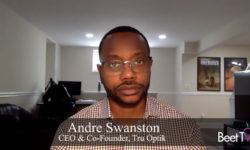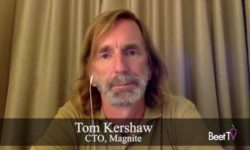CHICAGO – It is now four years since a hard-hitting ANA report, K2, blew the lid off practices in which US advertising agencies were accused of keeping up to 20% of clients’ media budgets for themselves after engaging in “pervasive” kick-backs and rebates.
That report kicked off more industry transparency about, well, lack of transparency – including large-scale efforts to shine a spotlight on how a series of “ad-tech taxes” along the ad-tech vendor chain are continuing to mean haziness and over-spend.
Despite the passage of time and effort, this year a PwC/ISBA report again made sobering reading, showing out-of-control and overly-complex supply chains, with 15% of advertiser spend unattributed for after a procession of platform fees.
Andrew Goode has had enough. In this video interview with Beet.TV, the EVP, Head of Biddable Media, North America at Havas Media Group explains efforts his agency has been making to clean things up.
Lower fraud, higher viewability
“We have a supply chain that had become bloated, full of players that weren’t really adding value on differentiated inventory supply,” he complains.
In 2017, the group developed its own tool to give clients a complete view of a programmatic buy, from where ads are going to how much they are spending. And the group has reduced the number of partners through which it is buying – supply path optimization (SPO).
“We made a step, a positive step forward to say, ‘We don’t want to have 42 supply vendors accessing our demand’,” Goode says. “We don’t want to have a lack of knowledge over where our dollars are going, so we consolidated this down to seven partners.
“We demanded financial, operational transparency, and subsequently, we’ve seen a lot of other holding companies and a lot of other discussion around this area. The more people are engaged in this, it helps clean up that environment.”
The exercise is working, Goode suggests. “The big implication from it or the big result of this, we’ve seen lower fraud, we’ve seen high viewability and we’ve also managed to start getting a grip on the price of media,” he says.
From SSP to DSP
The consolidation around fewer supply-side platforms (SSPs) and the change of focus means Goode and Havas Media are coming to see more value in a different kind of software.
Goode says demand-side platforms (DSPs) are now “pivotal”.
“DSPs used to be a gateway to supply and used to control those relationships themselves,” he says.
But now DSPs can facilitate Havas Media’s relationships with SSPs, Goode adds. That doesn’t mean the agency is ditching SSPs. On the contrary, Goode says he wants a closer relationship with fewer of them.
DSPs find supply
He sees DSPs diverging to focus on distinct media channels, playing a “key role”.
“The DSP helps us enforce those buying channels. I can’t buy them on SSP currently with the controls that we need to put in place for a campaign without a DSP,” he says.
“And so, we require DSPs to have those relationships with those SSPs that we choose.”
Case in point – when Havas Media this August launched “social equity marketplaces”, to bring forward ad supply from underrepresented businesses run by people of color, it was DSPs that helped it find SSP relationships that could rise to the call.
You are watching a segment from a Beet.TV series titled Programmatic Buying: Accountability & Transparency in Focus presented by MediaMath. For more videos from the series, please visit this page.





































